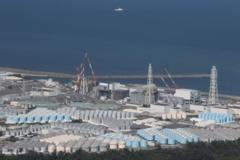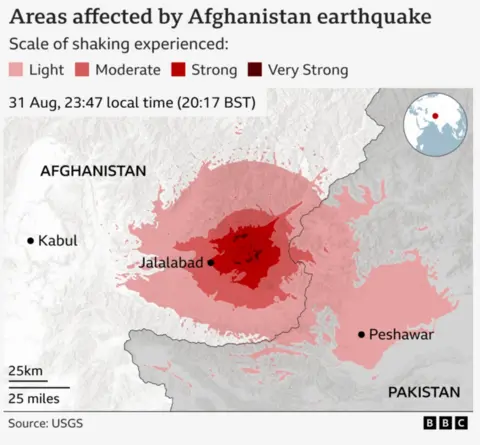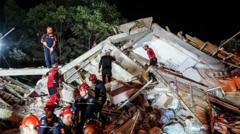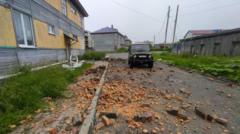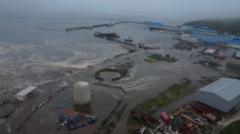On Wednesday, workers at Japan’s Fukushima nuclear plant were evacuated after tsunami warnings were issued throughout the country, prompted by an 8.7 magnitude earthquake that struck off Russia's far eastern coast. The plant's operator, Tokyo Electric Power Company Holdings (Tepco), confirmed the evacuation of all 4,000 workers, stating that there were no immediate abnormalities detected within the facility.
This tsunami alert echoes past traumas in Fukushima Prefecture, where a catastrophic 9.0-magnitude earthquake and subsequent tsunami in March 2011 triggered one of the world's most severe nuclear disasters. The 2011 catastrophe led to over 18,000 confirmed fatalities, massive reactor meltdowns, and extensive radioactive contamination. The threat of another tsunami understandably rekindles fears among locals and raises concerns over the ongoing management of hazardous materials at the site.
During the initial disaster, the massive tsunami disabled emergency cooling systems at the plant, resulting in meltdowns of three reactors and subsequent hydrogen explosions. The Japanese government declared a 30 km exclusion zone around the plant, forcing the evacuation of more than 150,000 residents due to radiation fears. Many regions around Fukushima remain largely deserted, bearing silent witness to the tragedy with abandoned homes and businesses.
As of now, an estimated 880 metric tons of hazardous material remain at the Fukushima facility, complicating the long-term plan for safe decommissioning that could take decades and require the work of tens of thousands of laborers. Tepco recently announced delays in the comprehensive removal of radioactive debris until at least 2037, leading experts to question the feasibility of decommissioning the plant by 2051.
In the context of Japan's energy needs, the government appears to be reassessing its nuclear policy after a long phase of public hesitance. Recently, there have been indications from the Japanese government about a potential return to utilizing nuclear energy to support growing demands in sectors like artificial intelligence and semiconductor production. Plans to construct new reactors are being reignited, but local resistance is palpable, especially amidst fears arising from the recent tsunami warnings and geological vulnerabilities.
Japan, situated on the seismically active Ring of Fire, experiences approximately 1,500 earthquakes annually. Earthquake preparedness is a significant part of the national culture, but the specter of a catastrophic earthquake remains, with experts predicting a significant quake could strike within the next 30 years, potentially resulting in severe casualties and tsunamis.
As Japan grapples with past tragedies and the complicated dynamics of its energy future, the evacuation of Fukushima workers underscores the deep-rooted anxieties tied to nuclear power in a nation that remains vulnerable to the forces of nature.
This tsunami alert echoes past traumas in Fukushima Prefecture, where a catastrophic 9.0-magnitude earthquake and subsequent tsunami in March 2011 triggered one of the world's most severe nuclear disasters. The 2011 catastrophe led to over 18,000 confirmed fatalities, massive reactor meltdowns, and extensive radioactive contamination. The threat of another tsunami understandably rekindles fears among locals and raises concerns over the ongoing management of hazardous materials at the site.
During the initial disaster, the massive tsunami disabled emergency cooling systems at the plant, resulting in meltdowns of three reactors and subsequent hydrogen explosions. The Japanese government declared a 30 km exclusion zone around the plant, forcing the evacuation of more than 150,000 residents due to radiation fears. Many regions around Fukushima remain largely deserted, bearing silent witness to the tragedy with abandoned homes and businesses.
As of now, an estimated 880 metric tons of hazardous material remain at the Fukushima facility, complicating the long-term plan for safe decommissioning that could take decades and require the work of tens of thousands of laborers. Tepco recently announced delays in the comprehensive removal of radioactive debris until at least 2037, leading experts to question the feasibility of decommissioning the plant by 2051.
In the context of Japan's energy needs, the government appears to be reassessing its nuclear policy after a long phase of public hesitance. Recently, there have been indications from the Japanese government about a potential return to utilizing nuclear energy to support growing demands in sectors like artificial intelligence and semiconductor production. Plans to construct new reactors are being reignited, but local resistance is palpable, especially amidst fears arising from the recent tsunami warnings and geological vulnerabilities.
Japan, situated on the seismically active Ring of Fire, experiences approximately 1,500 earthquakes annually. Earthquake preparedness is a significant part of the national culture, but the specter of a catastrophic earthquake remains, with experts predicting a significant quake could strike within the next 30 years, potentially resulting in severe casualties and tsunamis.
As Japan grapples with past tragedies and the complicated dynamics of its energy future, the evacuation of Fukushima workers underscores the deep-rooted anxieties tied to nuclear power in a nation that remains vulnerable to the forces of nature.

